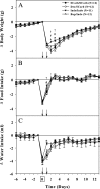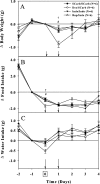Effects of indomethacin and buprenorphine analgesia on the postoperative recovery of mice
- PMID: 18702446
- PMCID: PMC2694718
Effects of indomethacin and buprenorphine analgesia on the postoperative recovery of mice
Abstract
Buprenorphine (Bup) is the most commonly used analgesic in mice, yet few objective assessments address its superiority for postsurgical recovery. In mice, IP implantation of a radiotelemetry device induces decreases in body weight (BW), food and water intake (FI, WI), core temperature (Tc), and activity levels that persist approximately 14 d in the absence of analgesia. To compare the efficacy of Bup with that of the nonsteroidal antiinflammatory drug indomethacin (Indo) for postsurgical recovery, male C57BL/6J mice were treated on the day of radiotelemetry implantation with Bup (0.3 mg/kg s.c.) or Indo (1 mg/kg s.c.) followed by treatment with Indo (1 mg/kg p.o.) on the next day (Bup-Indo versus Indo-Indo). Responses were compared between treatments in mice implanted with a radiotelemetry device and those that did not undergo surgery. Changes in BW, FI, WI, Tc, and activity were examined throughout 14 d of recovery. Indo-Indo was more efficacious in inhibiting postsurgical BW, FI, and WI reductions, compared with Bup-Indo. Bup also reduced BW and FI in the absence of surgery, indicating a nonspecific effect of this drug on these variables. Indo-Indo treatment was associated with higher activity levels during lights-on-to-lights-off transition periods compared with that observed with Bup-Indo. According to 5 objective measures of surgical recovery, our data suggest that Indo-Indo treatment is more efficacious than is Bup-Indo for postsurgical recovery of radiotelemetry-implanted mice.
Figures






Comment in
-
Effects of indomethacin and buprenorphine analgesia on the postoperative recovery of mice.J Am Assoc Lab Anim Sci. 2008 Nov;47(6):8; author reply 8-9. J Am Assoc Lab Anim Sci. 2008. PMID: 19069302 Free PMC article. No abstract available.
References
-
- Bauer DJ, Christenson TJ, Clark KR, Powell SK, Swain RA. 2003. Acetaminophen as a postsurgical analgesic in rats: a practical solution to neophobia. Contemp Top Lab Anim Sci 42:20–25 - PubMed
-
- Brewster D, Humphrey MJ, McLeavy MA. 1981. The systemic bioavailability of buprenorphine by various routes of administration. J Pharm Pharmacol 33:500–506 - PubMed
-
- Christoph T, Kogel B, Schiene K, Meen M, De Vry J, Friderichs E. 2005. Broad analgesic profile of buprenorphine in rodent models of acute and chronic pain. Eur J Pharmacol 507:87–98 - PubMed
-
- Cooper DM, Hoffman W, Wheat N, Lee H-Y. 2005. Duration of effects on clinical parameters and referred hyperalgesia in rats after abdominal surgery and multiple doses of analgesic. Comp Med 55:344–353 - PubMed
-
- Flecknell PA. 1996. Laboratory animal anaesthesia: a practical introduction for research workers and technicians. San Diego: Academic Press; p 136–157
Publication types
MeSH terms
Substances
LinkOut - more resources
Full Text Sources
Research Materials
